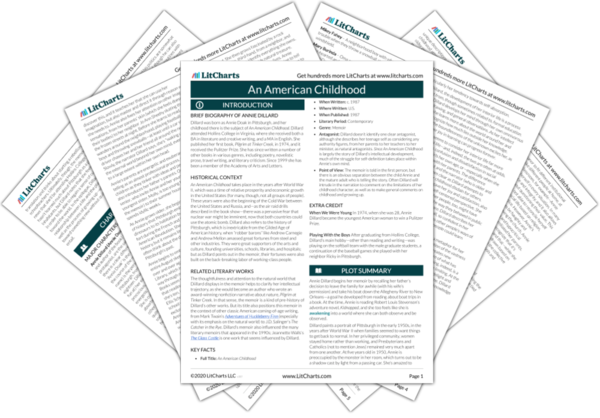Annie’s paternal grandmother is an elegant, tall redhead. Oma is alluring to Annie in her willingness to chat about adult subjects and include Annie in her daily domestic traditions. But Annie is also aware of a rivalry between Oma and her mother, who fight to have influence over Annie and Amy. Oma was raised very privileged, but Annie’s mother (and thus increasingly Annie as well) think of her tastes as tacky. She is, however, kind and generous to her family, even though she can also be close-minded and even racist.
Get the entire An American Childhood LitChart as a printable PDF.

Oma (Meta Waltenburger Doak) Character Timeline in An American Childhood
The timeline below shows where the character Oma (Meta Waltenburger Doak) appears in An American Childhood. The colored dots and icons indicate which themes are associated with that appearance.
Part One
...night for years. Her grandfather, Frank Doak senior, was a pot-bellied and funny banker; their grandmother Meta Waltenburger Doak, whom they called Oma, was kind and elegant, tall and redheaded. They...
(full context)
Oma told Annie that, as a teenager, she’d sewed rows of lace on her shirt to...
(full context)
...had died during the 1918 flu epidemic. She had a crucifix hung over her bed; Oma said, somewhat admiringly, that she was “stubborn” about her Catholicism.
(full context)
Oma had grown up an only child, rather wealthy, and with a limited view of the...
(full context)
Oma’s grandfather had arrived in Louisville, Kentucky from Germany in 1848 and opened a brass foundry...
(full context)
...kids, and spent evenings playing cards on the porch or coloring in coloring books with Oma. When they left the Lake, they would rise early and drive through Mennonite country, over...
(full context)
Annie sensed a rivalry between her mother and Oma. Mother had won morally, condemning Oma’s racism, but she still worried that Annie and Amy...
(full context)
Part Two
...a person’s interior life expands and thickens: she wakes up one day to discover her grandmother, then to discover boys. First there were the “polite boys” of Richland Lane, with parents...
(full context)
...an upper-school dance at the boys’ school, then ashamed of herself for feeling that way. Oma sold the Pittsburgh house and moved into a penthouse apartment for the fall; in the...
(full context)
Annie’s family had bought Oma’s house, high on a hilly street: nowhere higher up to go in life, Annie thought....
(full context)
Part Three
Annie also knew Oma’s world, but that was changing, now that Annie was working in the summers selling men’s...
(full context)
One day Oma returned from “looking at shoes,” as she said, and broke down, grieving for her husband....
(full context)
...her binoculars, she would wonder why anyone would prefer that to bird-watching. During the day, Oma and Mary shopped, and in the evenings they went out to dinner. Amy was bored...
(full context)












